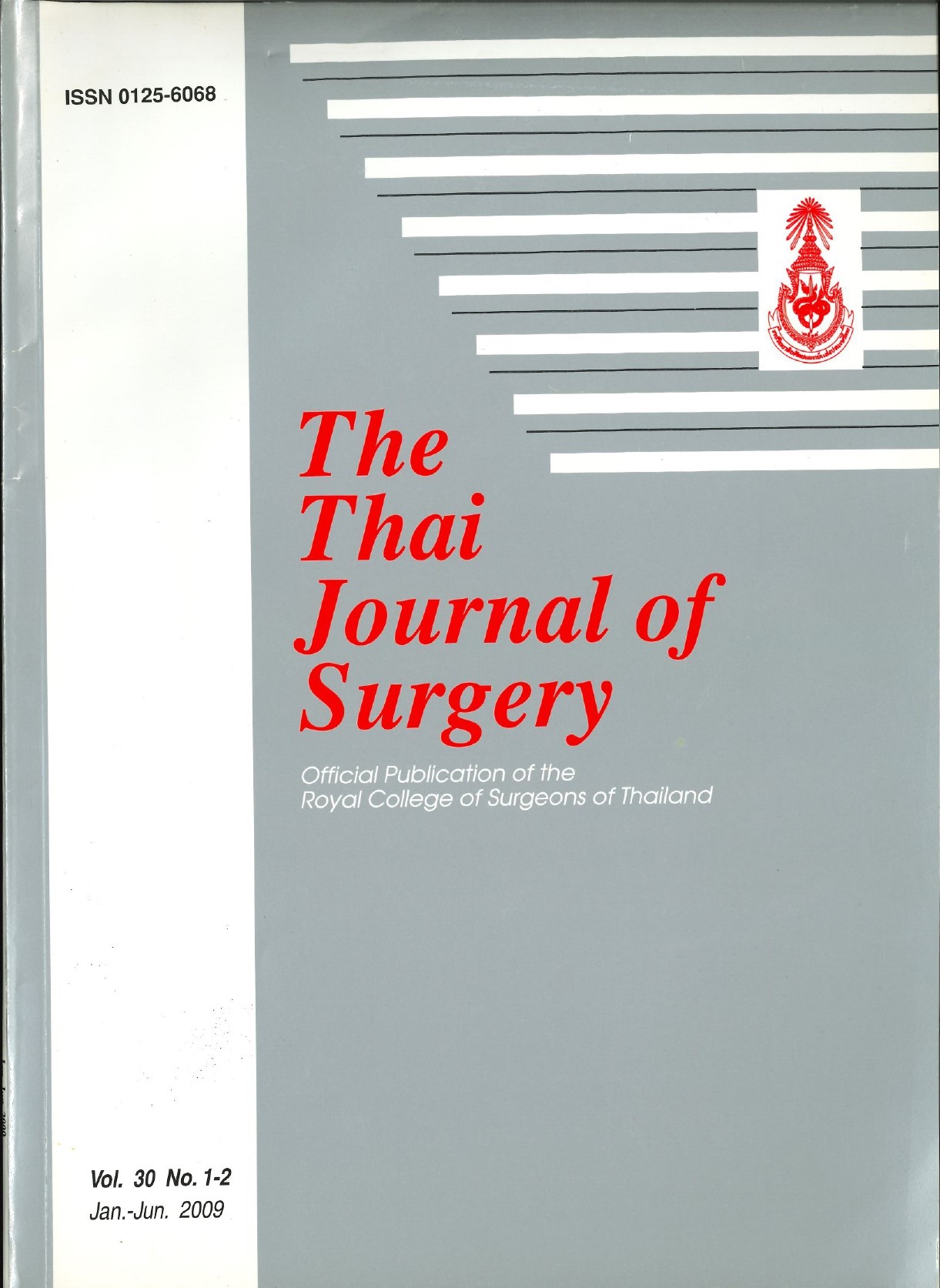How to Secure Cystic Duct Ligation for Laparoscopic Cholecystectomy - Back to Simple Basic
Keywords:
cystic duct, ligation, laparoscopic cholecystectomyAbstract
Background: Laparoscopic cholecystectomy (LC) is the gold standard treatment for symptomaticgallstone. There have been many techniques of cystic duct ligation reported but there are still many
complications due to failure of this ligation. The present study reviewed the outcome of LC performed whereby
cystic duct and artery were ligated by an ordinary silk.
Materials and Methods: This retrospective study reviewed the overall outcome of 121 patients who
underwent LC whereby cystic duct and artery were intracorporally ligated by simple silk. The procedures had
been performed during May 2002- December 2005. The following parameters were analyzed: age, sex, weight,
underlying diseases, previous surgery, diagnosis, anatomy of hepatobiliary system, operation time, length of
stay (LOS), the numbers of intracorporeal knots, complications and follow- up time.
Results: Of 121 patients, 2 patients (1.6%) were converted to open cholecystectomy. The mean age was
53.04 years and the average body weight was 59.45 kg. Ninety three patients (76.9%) were female and 28 patients
(23.1%) were male. The most common diagnosis was symptomatic gallstones without cholecystitis (86.7%).
Gallstones with chronic cholecystitis were found in 8.3%. The average operative time was 61.29 minutes (25-
160). The average LOS was 3.05 days and the average number of intracorporeal knots was 5.12 for each patient.
There were 12 patients who had complications in which the most common was bleeding in 5 patients (4.1%).
Intra-abdominal collection (bile leakage) occurred in one patient (0.8%) and this patient needed re-admission.
There was no main biliary duct injury and mortality.
Conclusion: The intracorporeal ligation of LC was feasible, economical and safe and it could manage
all kinds of cystic ducts. The author suggested the important steps to avoid complications: 1) keep standard 4-
port technique (3 of 5 mm. and 1 of 10 mm.), 2) first dissect posterior peritoneum of the Calot’s triangle,
3) create two windows over the Calot’s triangle, 4) use intracorporeal knotting, and 5) meticulously dissect to
look for anatomical variations.
References
ligation in laparoscopic cholecystectomy. Surg Laparosc
Endosc Percutan Tech 2008; 8:155-6.
2. Hanazaki K, Igarashi J, Sodeyama H, Matsuda Y. Bile leakage
resulting from clip displacement of the cystic duct stump: a
potential pitfall of laparoscopic cholecystectomy. Surg
Endosc 1999;13:168-71.
3. Saha SK. Ligating the cystic duct in laparoscopic
cholecystectomy. Am J Surg 2000;179:494-6.
4. Lim BS. Intracorporeal ligation of the cystic duct during
laparoscopic cholecystectomy. Surg Laparosc Endosc
1996;6:388-91.
5. Kitano S, Moriyama M, Sugimachi K. A simple and rapid
technique for suture ligation during laparoscopic
cholecystectomy. Surg Laparosc Endosc 1992;2:321-2.
6. Huscher CG, Lirici MM, Dipaola M, Crafa F, Napolitano C,
Mereu A, et al. Laparoscopic cholecystectomy by ultrasonic
dissection without cystic duct and artery ligature. Surg
Endosc 2003;17:442-51.
7. Lohde E, Gemperle A, Kraas E. Ligation of the cystic duct -
experience in 1750 laparoscopic cholecystectomies. Chirurg
1993;64:789-3.
8. Abbas IS. Overlapped-clipping, a new technique for ligation
of a wide cystic duct in laparoscopic cholecystecomy.
Hepatogastroenterology 2005;52:1039-41.
9. Yeh CN, Jan YY, Liu NJ, Yeh TS, Chen MF. Endo-GIA for
ligation of dilated cystic duct during laparoscopic
cholecystectomy: and alternative, novel, and easy method.
J Laparoendosc Adv Surg Tech A 2004;14:153-7.
10. Nowzaradan Y, Meador J, Westmoreland J. Laparoscopic
management of enlarged cystic duct. Surg Laparosc Endosc
1992;2:323-6.
11. Ota A, Kano N, Kusanagi H, Yamada s, Garg A. Techniques
for difficult cases of laparoscopic cholecystectomy. J
Hepatobiliary Pancreast Surg 2003;10:172-5.
12. Lee AY,Carter JJ,Hochberg MS,Stone AM,Cohen SL,Pachter
HL. The timing of surgery for cholecystitis: a review of 202
consecutive patients at a large municipal hospital. Am J
Surg 2008;195:467-70.
13. Seenu V, Shridhar D, Bal C, Parshad R, Kumar A. Laparoscopic
cholecystectomy: cystic duct occlusion with titanium clips
or ligature? A prospective randomized study. Trop
Gastroenterl 2004;25:180-3.
14. Belkhodja C, Porte H, Quandalle P. Pedicular traumas
during laparoscopic cholecystectomy. A propos of 5 cases.
Ann Chir 1995;49:149-54.
15. Woods MS, Shellito JL, Santoscoy GS, Jagan RC, Kilgore WR,
Traverso LW, et al. Cystic duct leaks in laparoscopic
cholecystectomy. Am J Surg 1994;168:560-3.
16. Muehlenberg K, Loffler A. Clip migration in the common bile
duct and consecutive calculus formation after laparoscopic
cholecystectomy. Z Gastroenterol 1995;33:108-11.
Downloads
Published
How to Cite
Issue
Section
License
Articles must be contributed solely to The Thai Journal of Surgery and when published become the property of the Royal College of Surgeons of Thailand. The Royal College of Surgeons of Thailand reserves copyright on all published materials and such materials may not be reproduced in any form without the written permission.



